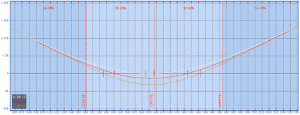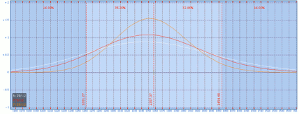One of the frustrating things about buying straddles is that the more correct you are, and the more quickly you are proven correct, the more quickly your position loses the ability to profit from volatility, writes Jared Woodard of CondorOptions.com.
A straddle opened as a bet on volatility quickly becomes a simple long/short bet on the underlying asset: straddles run out of gamma too quickly.
A straddle is a position comprised of one call and one put on the same underlying asset with the same strike prices and in the same expiration cycle. With S&P 500 December 2013 futures currently trading at 1748, a trader might buy the 1750 call and 1750 put expiring in December. Why? One reason traders buy and sell option straddles is to express views about the future volatility of the underlying. If you think a stock is likely to become more volatile, and you believe that option implied volatility does not already reflect your expectations, then buying a straddle will give you exposure to volatility without any exposure to the direction of underlying asset prices. The familiar payoff graph for a long straddle is at fig. 1.

Fig. 1. Straddle payoff diagram. Source: TD Ameritrade
Click
to Enlarge
The white line shows the profit and loss on the day that a long straddle trade is initiated. The red and green lines show the same profit/loss curve one and two months later. One thing we notice immediately is that as the price of the underlying asset moves further away from the strike price of our straddle, the straddle behaves more and more like a simple long or short position in the underlying.
To see why this happens, imagine that we buy calls and puts struck at 1750 and the futures then climb to 1900. The 1750 put we bought will have lost most of its value, so it will not have much of an impact on our position. At the same time, the 1750 call will be deeply in the money and will act more and more like the underlying. If our intent was to trade volatility expectations rather than price expectations, this is a big problem.

Fig. 2. Straddle gamma. Source: TD Ameritrade
Click
to Enlarge
Another way to illustrate the same issue is by looking at our expected gamma over time. Think of gamma as a sort of delta-generating machine: you can rent gamma machines to spit out favorable deltas that make you profits as the market moves. The cost to rent those gamma machines is your theta, your daily time decay. Fig. 2 shows the gamma exposure for the same straddle at the same time horizons as in fig. 1. (The strike prices in these figures are a little different, but the principles are the same.) Again, the distance from the strike of our straddle is the real enemy here: the further the underlying is from our strike, the less gamma our position has, and the less gamma we have, the less delta we generate as the underlying moves.
Assuming one standard gamma scalping approach, here’s how the problem plays out in practice. Every time the underlying asset moves enough to cover our daily time decay costs, we will buy or sell deltas in the futures to get our directional price exposure back to even (remember, we’re trying to trade volatility, not price expectations). But again, the further away we get from the strike price of the straddle, the smaller and smaller our daily gamma (and thus our daily profit potential) will be.
As you might expect, since the straddle is no longer giving us gamma machines, we also don’t have to pay as much rent in theta terms. But we still have capital deployed and, instead of tracking our expectations about volatility, that capital is just becoming less and less useful.
Because they are tightly linked to one strike price, straddles are very path-dependent. Even if your thesis about volatility between today and some future date proves correct, the extent to which your straddle used to express that view is profitable depends on the path that prices follow during the course of the trade. That sort of indeterminacy is really not attractive.
One potential solution is to trade positions and products that have volatility exposure but that are not path-dependent. Familiar volatility products like VIX futures and volatility ETPs fit the bill.
So, while volatility products might seem esoteric or even unnecessary on first glance, paying attention to the payoff properties of straddles reveals why they are an essential tool, after all.
By Jared Woodard of CondorOptions.com


















